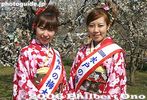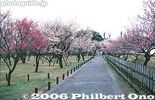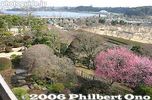Kairakuen Garden 偕楽園
|
Title   • File Name • File Name   • Date • Date   • Position • Position   |
|

Welcome to IbarakiTrain platform of Kairakuen Station.
|
|

Train platform of Kairakuen Station
|
|

Train platform of Kairakuen Station
|
|

Plum Blossom Queen at Kairakuen StationShe was passing out maps of the garden. It was a nice touch to see two of these kimono beauties greeting us.
|
|

Plum Blossom Queen
|
|

Entrance to garden via Tokiwa Shrine. One of Japan's three most famous gardens, Kairakuen is especially noted for thousands of plum blossom trees which bloom in Feb. and March.One of Japan's three most famous gardens, Kairakuen is especially noted for thousands of plum blossom trees which bloom in Feb. and March.
|
|

Tokiwa Shrine, MitoDedicated to Lord Mitsukuni Tokugawa, the second lord of Mito, and Nariaki Tokugawa, the ninth lord of Mito and the one who built Kairakuen Garden.
|
|

Bonsai plum treesI bought one of these once and the flowers smelled good before they withred away. The tree also died soon afterward.
|
|

Crowd at Higashi-mon East GateThis was the defacto main gate and most crowded since it is closest to the train station.
|
|

Map of Kairakuen, a garden built in 1841 by Tokugawa Nariaki (1800-1860), the ninth Lord of Mito. It is one of Japan's three most famous gardens.
|
|

Pinickers
|
|

Plum blossom-viewing picnickers
|
|

Red and white plum blossoms
|
|
|

White plum blossoms, the most common variety, and with the sweetest aroma.
|
|
|

Osaka-zuki red plum blossoms 大盃Osaka-zuki
大盃
|
|

Plum tree grove, about a week too early.
|
|

Fantastically-shaped plum tree
|
|

Konan Shomu plum blossom 江南所無Prunus mume Kounanshomu
|
|

Plum Blossom Queens in Kairakuen, Mito
|
|

Plum Blossom Queens in Kairakuen, Mito
|
|
|

Plum trees and Lake Senba
|
|

Plum trees and Lake Senba
|
|

Plum trees and Lake Senba
|
|
|

Torano-o plum blossom (Tiger's Tail) 虎の尾
|
|

Pine trees and plum trees
|
|

Plum tree grove
|
|

Plum tree and train
|
|

Monument proclaiming Kairakuen as one of Ibaraki's 100 Best Sights
|
|

Poem monument
|
|
|

Closeup of white plum blossom
|
|

Closeup of red plum blossom
|
|
|
|
|

Plum grove
|
|

Path to natural spring
|
|

Natural spring (cold water)
|
|

Bamboo grovePine trees, bamboo, and plum blossoms are called Shochikubai in Japanese. This trio of trees is most famous.
|
|

Omote-mon GateThis supposed to be the front gate.
|
|

Kobuntei Villa has exquisite Japanese-style paintings on paper sliding doors. Kobuntei was damaged by the March 2011 Tohoku earthquake and was closed until early 2012 for repairs.
|
|

Kobuntei Villa was originally built in 1842 by Tokugawa Nariaki (1800-1860), the ninth Lord of Mito. It was his summer villa.
|
|

Kobuntei Villa, fusuma sliding door with painting of plum trees
|
|

Kobuntei Villa, fusuma sliding door with painting of azalea
|
|

Kobuntei Villa, fusuma sliding door with painting of fall leaves
|
|

Kobuntei Villa
|
|

Kobuntei Villa
|
|

Kobuntei Villa
|
|

Kobuntei Villa, fusuma sliding door with painting of maple leaves
|
|

Kobuntei Villa
|
|

Kobuntei Villa
|
|

Kobuntei Villa
|
|

Kobuntei Villa
|
|

Kobuntei Villa
|
|

Kobuntei Villa, fusuma sliding door with painting of cherry blossoms
|
|

Kobuntei Villa
|
|

Cherry Blossom Room, Kobuntei Villa
|
|

Kobuntei Villa
|
|

Kobuntei Villa
|
|

Kobuntei Villa
|
|

Kobuntei suffered quite a bit of damage during the big earthquake on March 11, 2011. Repairs have started in Sept. 2011, and they hope to reopen the Kobuntei by Feb. 2012.
|
|
|
|
|
|
|
|
|

View from the top floor of Kobuntei Villa
|
|

View from the top floor of Kobuntei Villa
|
|

View from the top floor of Kobuntei Villa
|
|

View from the top floor of Kobuntei Villa
|
|

Inside the top floor of Kobuntei Villa
|
|

Inside the top floor of Kobuntei Villa
|
|

Balcony on the top floor of Kobuntei Villa
|
|
|
|
|

Kobuntei Villa
|
|

Kobuntei Villa
|
|

Kobuntei Villa
|
|

Natto fermented beans
|
|

Kairakuen StationThis station, right before Mito Station, is open only during major flower seasons of Kairakuen.
|
|
|
|
|